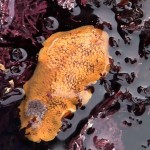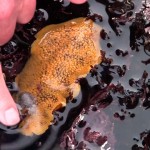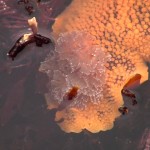Hundreds of visitors braved the chilly and rainy weather this past weekend (December 4th and 5th, 2010) and were rewarded with many beautiful sights, including this sea lemon nudibranch, Anisodoris nobilis. Some nudibranchs are hard to find, but this one was out in the open, relying on its bright coloring to tell predators not to try a bite of its very acidic-tasting flesh. It was probably searching for food. Sea lemons apparently prefer sponges, and consume them by rasping them with their file-like radulas, tooth-studded tongue-like structures found in many mollusks.
As the photo showing a friend’s fingers demonstrates, this one was between 3 and 4 inches long, which also helped make it more visible than some of its smaller brethren. This type of nudibranch only lives to be about a year old, so it must be dining well to grow so large!
Note the frilly translucent-white gill structure on the back through which the nudibranch breathes. The word nudibranch means “naked lungs.” When a nudibranch feels threatened, for example when you touch it, it quickly retracts its unprotected breathing apparatus. If you watch it for long enough, it will eventually relax enough to extend its gill structure again.



